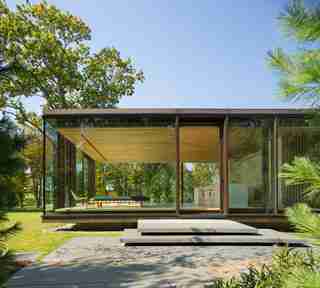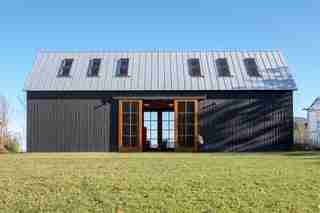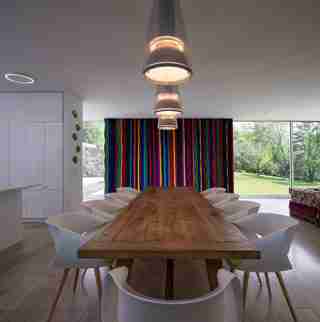Picture your dream house—what first comes to mind? The scale? The layered interiors? Which architect to call on to perfect your vision? According to David Sokol, a New York–based journalist who writes on architecture and design, a sense of place can be as dynamic as a structure itself. In his new book, Hudson Modern: Residential Landscapes (The Monacelli Press) , to be released this week, Sokol highlights 18 handsome homes in New York's Hudson River Valley, where he once called home. Though residents' motives may differ—a respite for weekenders escaping the pulse of New York City, an enclave for artists and creatives, a cradle of sustainable farms and lush vineyards—they all travel to the Hudson Valley for nature, for breathing room, for place .
What culminates is a specific type of living that is forward-thinking yet homey and unpretentious. In the past decade, Sokol notes the growth of a collective spirit in the region's architecture—more earnest than the playful modernism of Fire Island, less cerebral than that of the Hamptons. "It's tactile, it's really familial, and it's meant for socializing and close relationships," Sokol says. "For the most part these aren't glass boxes where the person can simply be inside or outside." What sets these projects apart is their dependence on the surrounding landscape to be fully whole. Steven Holl's angular guesthouse—though a clear feat of design—would be puzzling nestled on a suburban cul-de-sac. "They didn't just plop these homes down—they were really thoughtful, deliberate, and intellectual about it," Sokol explains. "They were really able to balance experimentation as architects and a sense of place."

LM Guest House—with architecture by Desai Chia Architecture—pays homage to Ludwig Mies van der Rohe's 1951 Farnsworth House, an iconic glass-walled residence, while maintaining a specifically Hudson Valley feel. A view into the home's living room displays how the subtle silhouettes of midcentury furniture play well with generous windows.

Old Field Farm—the 160 acre plot of artist Peter Nadin—features a greenhouse, studio, office and apartment, and more, and was conceived by architect Michael Haverland. Here, 14-foot doors open into Nadin's studio.

At House 432—which lies at the southeastern edge of the Hudson Valley—architect Robert Siegel was inspired by the manifold qualities of the landscape and paid homage to the historical plot, once the brick lot for the estate of John Jay, the first supreme court chief justice. The dining area exemplifies the decidedly contemporary living spaces, which juxtapose the stone-clad exterior.
House 432 features hidden enclaves, like this rooftop courtyard.
The guesthouse of architect Steven Holl's estate in Rhinebeck—named Ex of In—is a case study of his work with intersecting spheres. Though a mere 918 square feet, the angled volumes and unconventional windows create roomy, breathable interiors.
A porthole window at Ex of In extends two stories.
Inside, sleeping areas are tucked away on the second floor while a sitting area takes in sweeping forest views.
The River House occupies a section of Wyndclyffe, the 80-acre estate of Elizabeth Schermerhorn Jones, which was sectioned off after its desertion in 1950. Architect Steve Mensch designed this low-lying, stone-clad residence (featured in AD , July 2016 ) in opposition to the bygone Gothic manse. Here, a flagstone courtyard welcomes direct contact with nature.
Outside LM Guest House, Sokol notes how the structure's interior partitions never intersect with the building perimeter.
